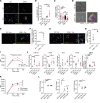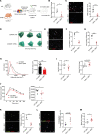Osteopontin promotes age-related adipose tissue remodeling through senescence-associated macrophage dysfunction
- PMID: 37092554
- PMCID: PMC10243739
- DOI: 10.1172/jci.insight.145811
Osteopontin promotes age-related adipose tissue remodeling through senescence-associated macrophage dysfunction
Abstract
Adipose tissue macrophages (ATMs) play an important role in obesity and inflammation, and they accumulate in adipose tissue (AT) with aging. Furthermore, increased ATM senescence has been shown in obesity-related AT remodeling and dysfunction. However, ATM senescence and its role are unclear in age-related AT dysfunction. Here, we show that ATMs (a) acquire a senescence-like phenotype during chronological aging; (b) display a global decline of basic macrophage functions such as efferocytosis, an essential process to preserve AT homeostasis by clearing dysfunctional or apoptotic cells; and (c) promote AT remodeling and dysfunction. Importantly, we uncover a major role for the age-associated accumulation of osteopontin (OPN) in these processes in visceral AT. Consistently, loss or pharmacologic inhibition of OPN and bone marrow transplantation of OPN-/- mice attenuate the ATM senescence-like phenotype, preserve efferocytosis, and finally restore healthy AT homeostasis in the context of aging. Collectively, our findings implicate pharmacologic OPN inhibition as a viable treatment modality to counter ATM senescence-mediated AT remodeling and dysfunction during aging.
Keywords: Adipose tissue; Aging; Extracellular matrix; Immunology; Macrophages.
Figures





References
Publication types
MeSH terms
Substances
LinkOut - more resources
Full Text Sources
Medical
Molecular Biology Databases
Research Materials
Miscellaneous

